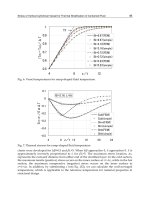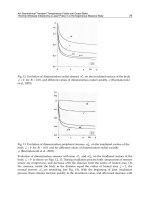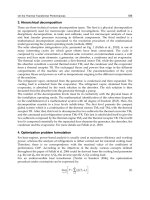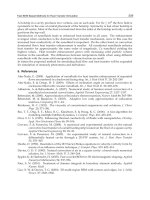Data Analysis and Presentation Skills Part 7 doc
Bạn đang xem bản rút gọn của tài liệu. Xem và tải ngay bản đầy đủ của tài liệu tại đây (301.03 KB, 19 trang )
from a hand-drawn plot where the line of best fit has been
drawn in by placing a ruler onto the plot and determining the
best place to draw the line manually, we now have a more
accurate means of quantitating our unknow n value. This means
rearranging Equation 4.2 to solve for x:
x ¼ðy þ 0:0079Þ=0:0053 ðEquation 4:8Þ
So if we had an absorbance reading of 0.1 then, if we substitute
this in the rearranged equation, we should obtain a value of
20.4 mg/ml for concentration.
Multiple regress ion
In the previous sections we h ave investigated the relationship between one
(independent) variable and another (dependent variable).T here may be times;
however, when we suspect that there is a relationship between more than two
variables and that these are interdependent. To determine how to relate these
variables we must use multiple regression.
In simple linear regressio n we demonstrated the relationship between x and
y as:
y ¼ mx þ c ðEquation 4:6Þ
In multiple regression we imply that y is linearly dependent on one variable (x
1
)
and also dependent on another variable (x
2
), so :
y ¼ m
1
x
1
þ m
2
x
2
þ c ðEquation 4:9Þ
T his equation assumes that the de pendent variable, y, is depende nt on two
inde pendent variables, x
1
and x
2
. m
1
and m
2
are partial regression coe⁄cie nts
because they can re £ec t how a value of y would change with a unit change of x
1
if x
2
were held constan t, and vice versa.Where y is dependent on more than one
variable, then the equation may be adapted to include as many variables as
necessary. So if y is dependent on four variables the n:
y ¼ m
1
x
1
þ m
2
x
2
þ m
3
x
3
þ m
4
x
4
þ c ðEquation 4:10Þ
102 4PRELIMINARYDATAANALYSIS
In multiple regression we are able to obtain an equation from which we are
able to predict y from value s of x
1
, x
2
, etc. and so develop an understanding of
which variables are able to a¡e ct y. This is a usef ul function for exploring
complex relationships as within living systems it is unusual to ¢nd that an
assoc iation is restricted to just two variables.
Exercise 4.5
The systolic blood pressure of an individual is thought to be
related to a per son’s age and weight. Table 4.9 shows the age,
weight and systolic blood pressure for a sample of eight healthy
subjects. Enter the data as shown onto an Excel worksheet.
Note that the dependent variable (systolic blood pressure), y,
is kept on the right in one column; the independent variables
(x
1
and x
2
, age and weight) are kept together on the left. As in
the previous exercise, from the ToolsjjData Analysis menu
highlight Regression from the drop down menu. In the dialogue
box:
1 for Inpu t Y range: type in the cell references for the column
that contains the independent values (systolic BP) including
the title.
2 for Input X range: type in the cell references for the columns
containing all of the dependent variables (the two remaining
columns), again including titles.
3 In the dialogue box, click on Labels, Residuals, Residual
Plots, and Line Fit Plots.
103CORRELATION AND LINEAR REGRESSION
Table 4.9 Age, weight and systolic blood pressure in eight healthy subjects
Age (years) Weight (kg) Systolic BP (mmHg)
50 77.3 130
53 79.5 135
56 81.8 140
59 84.0 145
60 88.6 150
62 90.9 155
65 93.2 160
70 97.7 165
4 In Output options, type in a cell ref erence on your worksheet
where you would like the statistics to appear and confirm
your selection with OK.
A complete analysis of the multiple regression model should
now appear on your worksheet.
Interpretation of the regression analysis
The R-squared value of 0.992 indicates that there is a
relationship between the variables and that systolic blood
pressure may be explained using a linear model, where age
and weight are explanatory variables. The residual plots are a
useful check as to whether the assumption of linear regression
is appropriate. The output from Excel gives residual plots for
each of the variables. As may be seen from the output, each of
the comparisons shows that the points are clustered around
the central line. If there was no likeliho od of a relationship
between variables, then the points would show a purely
random scatter.
Using the TREND function
If we are satisfied that the regression analysis demonstrates a
relationship and that the resulting equation can be used as a
model, then if there were four subjects of known age and weight,
it could be useful to predict what their systolic BP would be.
Enter the following values on your worksheet underneath the
columns for Age and Weight: (leave a few rows blank between
these theoretical values and your actual data).
Age (years) Weight (kg)
54 71.2
55 71.2
56 71.2
57 71.2
10 4 4PRELIMINARYDATAANALYSIS
Choose a group of cells to contain the predicted (SBP) values
(the four cells to the right of those just used for the theoretical
values would be the most logical) and select them.
Click on the Paste Function button and choose TREND from
the Statistical list. The TREND box appears in which you are
prompted to enter the raw data and the range of cells
containing the information for which you require predictions
made (this function can be also be applied in simple linear
regression), as shown in Figure 4.12.
Type in the ranges on your sheet that contain your observed
y-values (SBP), the observed x-values (age and weight). This
time do not include the labels.
In the box labelled ‘const’ type in 1 (meaning True). (This
confirms that an intercept term is required for the equation
describing the relationship between the variables.) Then click
Finish.
Now move to the rows that were selected for inputting the
predicted values.
Press the Function key, F2. The word Edit should appear on
your status bar at the bottom of the screen. Hold down both
Control and Shift keys and press Enter. The formula bar should
now display the TREND function and the cell references for the
observed and predicted values, and the predicted values
should appear in the selected cells.
The values are based on a best-guess prediction, where a 95
per cent prediction interval uses the best guess plus or minus
105CORRELATION AND LINEAR REGRESSION
Figure 4.12 Using theTREND function in Excel
two standard errors of the estimate. We can therefore be 95
per cent confident that the systolic blood pressure will lie in this
range.
WEB SUPPORT – SECTION FOUR
Here you will ¢nd some examples to work through to look at the shape of
distributions and calculate the appropriate descriptive statistics. There
will also be some exercises to work through on correlation and
regres sion.Worked solutio ns will be available for all of the exercises.
106 4PRELIMINARYDATAANALYSIS
5
Statistical Analysis
So far we have considered how as part of a scientific
investigation we design experiments based on previous
research in which we test our interpretations that are
formulated into a hypothesis. As part of the design process
the most appropriate statistical analysis for the data should
be con sidered, keeping our plan for the investigation as
simple as possible. In this section we look at the most
commonly used statistical tests and how we may apply them
using Excel.
5.1 Selecting a statistical test
Before star ting a plan of work, we have to conside r very carefully the design of
the experiment to ensure that we are conducting a fair test. At the end of the
experiment we use a statistical test in order to establish whether or not our
hypothesis can be accepted. The purpose of applying statistical tests to
experimental data is to determine whether there is a signi¢cant di¡erence in
our observations that is, to examine the probability that our samples are
di¡erent.
Probability
Probability is a means of quantifying the likelihood of a partic ular event taking
place. By an eve nt we mean the result of an experiment that is of par ticular
Data Analysis and Presentation Skills by Jackie Willis.
& 2004 John Wiley & Sons, Ltd ISBN 04708 52739 (case d) ISBN 0470852747 (pap erback)
inte rest. In conducti ng the experiment we are gathering data in order to
determine the outcome of the investigation. In designing o ur study we have to
make sure that we do not intro duce any bias into the investigation s o that the
outcome is measured as fairly as possible. This frequently means ensuring th at
the sequen ce in which samples are taken (trials) are performed in a random
order. By performing a number of trials we are able to gather information on
the probability of an event taking place.
If we were to toss a coin 50 times and record the result of e ach toss (heads or
tales ), we cou ld determine the number of heads recorded for each 10 tosses.We
would expect that our chances of obtaining heads would be 50:50, that is there
is a 1 in 2 probability (0.5 expressed as a decimal) of obtaining heads.
During the course of the experiment we would see that as the number of
trials increases, the chance of obtaining heads gets closer and closer to 0.5.
From the experiment we can say that the probability of bein g able to toss a
head is:
number of events
number of trials
¼ 0:5
If the probability of an event occ uring is P th en the probability of it no t
happeni n g is (1 À P), i.e. the probability of obtaining tails with tossing the coi n
is (1À0.5). Probability is freque ntly converted into a percentage, so the
probability of tossing a head is 50 pe r cent.
Exercise 5.1
Seventy seeds were scattered on agar in a petri dish and kept
in the dark at 158C for 14 days. At the end of this period 37
seedlings were observed. What is the probability of the seeds
germinating under these conditions?
i.e. 37/70 ¼0.53 (53%)
Calculating probability
We can use the formula bar in Excel to calculate this probability, and
convertitintoapercentage:
108 5 STATISTICAL ANALYSIS
Open a new workbook in Excel.
Click on an empty cell on the Excel spreadsheet.
Enter the formula ¼37/70.
Press the Enter key and the probability will appear on your worksheet
(0.5287).
If we want to modify the formula to show th e percentage, then we must
click on the cell again and adjust the formula to read ¼(37/70)
*
100.
We would conclude that the probability of seeds germinating under the
speci¢ed co nditions is 53 per cent.
T he probability that the seeds will not germinate is
170.5287 ¼0.4714,which is the same as saying (70737)/70, so the
probability of the seeds not germinating is 47 per cent.
In choosing which type of statistical test is best for our data we need to
consider, at the planning stage, the characteri sti cs of data that we are goi ng to
collect.
T here are a number of statistical tests that can be used to determine whether
there is a sign i¢cant di¡eren ce between two samples.These are the:
. Z-test for independent samples
. Z-test for paired (matched) samples
. t-test for independent samples
. t-test for paired (matched) samples
. Mann^Whitney U-test
. Wilcoxon signed rank te st
. Chi-squared te st (see section 5.4).
In order to decide which is the most appropriate we have to take account of a
number of factors abou t the data that we are dealing with.
Types of data
Data can be described as continuous or discrete.
109SELECTING A STATISTICALTEST
By continuous data we mean that data have been quant i¢e d in some way. Its
accuracy will be dependent on the precision with which it has been measured .
For example, we may have used the Lowry method to determine the amount of
protein in a given sample. We may then report its protein content, but the
number of decimal places th at we would choose to use to report the value is
dependent on the preci sion of the analytical techniqu e.
With discrete data we are dealing with exact numbers, usually determined
by a counting method. This could be the number o f petals on a £ower, heart
rate, or cells counted using a haemocytometer. In each case we are dealing with
exact numbers, so we would have 6 petals, 60 heartb eats per minute or 12 cells
in a grid.
In each of these two examples, data is numerical an d has been measured or
counted and th erefore has de¢nitive values. These data are also known as
inte rval data.
The statistical tests that are applied to interval data are the Z-test and the
Student t-test.
Not all data ge nerated i n an experim en t is precise in this way. Sometimes we
may n eed to consider variables more di⁄cult to quantif y, such as an emotional
response or the severity of a disease. Th is type of variable cannot be measured
accurately; this type of data is known as ordinal data. Statistical tes ts that may
be applied to ordinal data are the Mann^Whitney U-test or the Wilcoxon
signed rank te st.
In certai n exper imen ts we may need to collect information that is descrip-
tive about the subjects in our investigation. Where data are descriptive, we
tend to summarize the information by placing it into di¡erent categories.
E xamples of categorical data include eye or hair colour, species within a genus,
or male/female subjects. Data that are categorical are also known as n ominal
data. The Chi-squared test is applied to data at the nominal level.
Independent and paired samples
In planning an experiment we try to eradicate as many sources of variation as
possible by limiting the number of factors likely to in£uence our results. This
sometimes involves generating what are known as matched or paired samples.
Where data are paired, the test variable is measured within the same experi-
mental subject or sample. By providing information from the same subject it is
possible to eliminate variability that may occur between samples and so each
individual will act as their own control. Data that are not matched or paired are
indepe nde nt.
110 5 STATISTICAL ANALYSIS
Characteristics of the sample population
The choice of test used will depend upon the characte ris tics of the population
from which the sample is taken, i.e. whether it is normally distributed, skewed
or bimodal. In section 4.2 we considered normal distributi ons and deviati ons
from normali ty. In some instan ces we will know the shape of the population
(e.g. heights of individuals are normally distributed) or are able to make the
assumption that it is normally distributed on the basis of comparison with
similar distributions. More usually the shape of the population is unknown
but, providing the sample taken is large enough, it may be possible to assume
that it is representative of the rest of the population and is normally distrib-
uted. It is also possible to test whether data complies with a normal
distribution.The C hi-squared goodness of ¢t test described in s ection 5.4 may
be applied to test for normality.
The size of the sample
The larger a sample, the more representative it will be of the population from
which it has been taken. If a slight signi¢can t di¡erence exists between the
mean values of two populations, a test that includes a large number of samples
will be more sensitive to detect this di¡erence than one involv ing a small
number of samples. As already discussed in section 2.2, we have to ensure th at
the si ze of sample use d in an investigation is large enough to preve nt a Type I
error occurring, otherwise small di¡erences will remain undetected. At the
same time we have to b e aware that there may be environmental or resou rce
issues that enter into a decision about sample size.
5.2 Statistical tests for two samples
For samples th at contain more than 30 subjects, the Z-test is usually preferred.
Biological investigations quite frequently involve small samples. Under these
circumstances it is important to know somethi ng about the shape of the
distribution of the population from which the sample has been taken.Where it
appears that the data approximate to a normal distribution (follow a typical
bell-shaped curve) then the t-test i s generally used. Where th e shape of the
sample deviates from a normal distribution, i.e. is skewed, or there is uncer-
tainty about the shape of the population, the Mann^Whitney or Wilcoxon
signed rank test would be applied.
111STATISTICAL TESTS FOR TWO SAMPLES
Stan dard deviation of the population
In most instances the standard deviation of the populat ion can only be deter-
mined from the sample data. If the samples are large, the estimate s o f the
standard deviation should be reliable and the Z-test may be used (irrespective
of the shape of the population).
If the samples are small (les s than 30), est imates will be poor and the t-test
should be use d , providi n g the samples i ndicate a normal distribution.
Table 5.1 provide s a summary of the factors that need to be considered when
choosing a statistical test.
The Wilcoxon and Mann^Whitney tests are kn own as non-parametric tests
because, unlike the t-tests, they may be used on data that may or may not
follow a normal distribution (distribution free). The t-tests are therefore
known as parametric tests as they may only be applied where the data is known
to comply with normality.
Hypothes is testing
Hypotheses are used by investigators to de¢n e the purpose of their experi-
ment. For a hypothesis to be accepted it must be tested; on the basis of the tes t
results the hypothesis is either supported or rejected, or may need to be
mod i¢ed.
The null hypothesis and the direct ion of the a lte rnative hypothesis
In statistical analysis we formulate a null hypothesis (H
0
) for our experiment
and it stands against the alternative hypothesis (H
1
).The null hypothesis makes
an assumption that the factor under inves tigation has no e¡ect; whereas the
alter native hypothesis is formulated on the assumption that the factor does
have an e¡ect.
112 5 STATISTICAL ANALYSIS
Table 5.1 Statistical tests for matched or inde pendent samples
Sample
size Distribut ion Matched samples Independent samples
n430 Normal or skewed Z-test (matched) paired sample s Z-test independent samples
n530 Normal Paired t-test Independe nt t-test
n530 Normal or skewed W|lcoxon signed rank test Mann^Whitney U-test
In considerin g how we should state the alternative hypothesis we have to
re£ect on the scienti¢c evidence on which our experiment is based, as we n eed
to determi ne whether there is only one possible outcome in our investigation
or more than one outcome. The tests that may be applied are either one-tailed
or two-tailed.
If the alternative hypothesis speci¢es a direc tion (i.e. there can only be one
signi¢cant consequ ence of our experimen t), then a one-tailed test is used. If
the alternative hypothesis doe s not have a direction (i.e. more than one
outcome is possible) then a two-tailed test is used.
Example of a one-tailed test
A chemical additive in a cosmetic is conside red to have carcinogenic proper-
ties. In an experiment to determine wheth er this can be con¢rmed a group of
rats have the cosmeti c applied to their skin. A control group of rats (numbers
equal in each group) have the same cosmetic applied but without the suspect
chemical pres en t. Each group of rats is mo nitored for the appearance of
malignant growths.
In this experiment there is only one possible outcome for the exp eriment,
either the rats will develop tumours or they will not, so there is only one
possible direction that is being tested.We would therefore adopt the one-tailed
test for our alternative hypothesis.
Example of a two-tailed test
If we were i nvestigating the e¡ects of a new chemical being developed as a
fertilizer for tomato plants, in the absence of any previous work, we would be
unsure of what e¡ect the substance might have on the growth of the plants. If
we wanted to design an experiment to determine the e¡ects of the chemical we
would probably start by taking a group of plants and dividing them into two
sets. One set would form a control group that would not be exposed to the
chemical, whilst the other would be grown under identical conditions but
with the chemical applied. After a set period of time we would examine the
two samples to establish whether the growth of the plants had been altered.
It may be that the chemical is e¡ective and promotes plant growth or that it
proves ine¡ective or maybe even brin gs about the stunting of growth. In this
experiment we cannot be certain of the direct ion of the outcome and so it is
appropriate to adopt the non-directional two-tailed te st. The null hypothesis
would therefore state that there would not be any di¡erence in plant growth
113STATISTICAL TESTS FOR TWO SAMPLES
between control and treated sets of plan ts; the alternative hypothesis would
prop ose th at there is a di¡erence in plant growth but would not spec ify
whether growth would be likely to increase or decrease.
A caut ious approach should be taken when consideri n g whethe r to adopt
a one-taile d test; the majority of statistical analyses are performe d using a
two-tailed test. Once an experiment has been completed, the direction of a
change in the test variable compared with a control is som etim es very clear
from looking at the results. It should be decid e d be fore the experiment has
taken place that it is appropriate for a one-tailed test to be adopted; this
must be on the basis of scienti¢ c evidence that there can o nly be one direc-
tion, i.e. one possible outcome for the experiment, if the results prove to be
signi¢c ant.
Level of signi¢cance
In a statis tical analysis we are testing our certainty of accepting the null
hypothesis. Before a tes t is performed, the level of signi¢cance for the rejec-
tion of the null hypothesis must be decided. Although the level of signi¢can ce
can be set to any value, it is usually set at 5 per cent (P50.05).T his means that
the likelihood of the event taking place by chance alone is 5 or less in 100 (so
there is at least a 95 per cent probability that the null hypothesis is correct),
i.e. it is very unlikely to take place by chance alone. The lower the level of
signi¢c ance that is adopted, the less likely it is that the nul l hy pothesis will be
rejected.
Presentation of a statistical test
Using Excel for statistical analysis makes it easy to write on the worksheet the
full basis of the test being adopted and the conclusions that may be drawn
from the analysis. The hypothe ses and details of the tests applied to data
should always be clearly state d, as should a de s cription of the results and your
conclusions from the analysis. You may ¢nd it usef ul to use the following
checklist for each analysis you perform.
1. State the nu ll and alternative hyp oth ese s, indicating a direction to the
alter native hypothesis if appropriate.
2. Indicate whe ther the test is one-tailed or two-tailed.
114 5 STATISTICAL ANALYSIS
3. Provide the name of the test applied (and assumptions about the popu-
lation from which the samples to be tested are drawn).
4. Set the level of signi¢cance at which the null hypothesis will be
rejected (normally P50.05).
5. Input the data in to a table on the worksheet and apply the test.
6. State the outcome of the statistical analysis, i.e. whether the null or
alternative hypothesis is accepted , together with the level of signi¢-
cance found i n the test.
7. Commen t on the data, i.e. what the test has shown (e.g. an increase in
plant growth using the fertilizer with an mean increase of15 per cent i n
the size of tomatoes). It mayalso be pertinent to comment on the qual-
ity of the data used or variability found in the experiment.
Using the statistical functions in Excel
Statistical tests may be accessed through the Data Analysis functions
from the Tools menu. The computer that you are working on may not
already have these fun ctions available, so before you commence your
analyses:
Click on Tools: Data Analysis
If the Data Analysis fun ctions do not appear at the bottom of the drop-
down menu then:
Click on Tools: Add-Ins, then click on the Analysis ToolPak from the
checkl ist that appears. The Data Analysis option should now appear
when you click onTools. (N.B.You may need the original CD that Micro-
soft Excel was loaded from if you are accessing the software from your
computer’s hard drive.)
Writing on your worksheet
When typing information and comments on your worksheet, it is easier
to use textboxes than to type directly into cells. Using the textbox will
prevent some of the text becoming ‘hid den’ within the cells and prevents
text over£owing from one page to another, which you can sometimes be
unaware of unless the document has been formatted carefully before
printing.
To use textboxes click on the Draw icon on the toolbar and then click on
theTextbox icon to enter your comments.
115STATISTICAL TESTS FORTWO SAMPLES
The Student t-test for independent samples
Exercise 5.2
An investigation was conducted on the effects of dietary fat in
margarine on serum cholesterol concentrations in male sub-
jects. In a controlled experiment 12 male subjects were given a
diet that used a standard ‘low fat’ margarine. A separate group
of 12 male subjects were provided with a diet that substit uted a
new type of margarine reported to significantly lower seru m
cholesterol in comparison with other brands. The subjects were
given the diet to follow for six months, then their serum
cholesterol levels were compared. In the first group one
subject discontinued the study, leaving only 11 subjects. The
serum cholesterol values for the two groups of subjects are
compared in Table 5.2.
The independent t-test was adopted for the data of Table 5.2
on the following basis:
1. The serum cholesterol of the subjec ts is measured at the
interval level.
2. The subjects from both groups were chosen at random from
a population of medical students, and so were not matched
with one another (ruling out the use of a paired test).
3. Previous experiments have demonstrated that the serum
concentrations of cholesterol in humans is normally dis-
tributed and this assumption was made about the test
subjects.
116 5 STATISTICAL ANALYSIS
Table 5.2 Serum cholesterol concentrations in subjects after 6 months on di¡erent die tary
regimens
Seru m cholesterol concentration (mg/dl)
‘Low fat’ margarine 175 168 154 163 171 134 149 151 147 155 162
‘New’ margarine 139 145 165 132 170 144 136 162 159 161 168 168
4. The range of the distributions for the two groups were not
widely different, so the standard deviations of the groups
are unlikely to be dissimilar.
‘Low fat’ margarine: Range ¼1757134 ¼41 mg/dl
‘New’ margarine: Range ¼1707132 ¼38 mg/dl
(The standard deviations needed estimating).
5. The size of each sample is less than 30, making it
appropriate to use a t-test for independent samples.
Null hypothesis: The type of margarine provided in the diet of
the test subjects has no effect on their serum cholesterol
concentrations.
Alternative hypothesis: The type of margarine provided in the
diet of the test subjects does have an effect on their serum
cholesterol concentrations.
Test: Two-tailed t-test for independent sampl es. (We cannot be
sure of the direction of the outcome as the new margarine may
cause serum concentrations to increase or decrease, or remain
unaffected.)
Level of significance: P ¼0.05 (5 per cent).
We can now perform the test using the Data Analysis option in
Excel.
Enter the data onto the worksheet in two columns as shown
below:
Low fat margarine New margarine
175 139
168 145
154 165
163 132
171 170
134 144
149 136
151 162
147 159
155 161
162 168
168
117STATISTICAL TESTS FORTWO SAMPLES
Select the Data Analysis function from the Tools menu.
Choose t-test: Two Sample Assuming Equal Variances from the
menu.
A dialogue box as shown in Figure 5.1 will appear in which to
input the cell references for each column of data as the Variable
1 range and Variable 2 range. Include the rows that have the
titles for your data in your selection and tick the check box that
shows Labels. Ensure Alpha is set at 0.05, the default value,
which is the level of probability that will be adopted for the test.
(0.05 means that you are assuming the 5 per cent level of
probability.)
Now select where you would like your results to appear in the
workbook. If you do not alter this to your current workshee t
then the analysis will appear on a separate sheet. It is usually
more convenient to se lect an empty cell below your data table.
To accomplish this, click on Output Range and either select a
cell on your worksheet or type in the cell reference (e.g. B15).
Click on OK and the statistical analysis will be summarized on
the worksheet as shown in Figure 5.2. We now need to examine
results of the analysis and comment on the outcome of the
test.
118 5 STATISTICAL ANALYSIS
Figure 5.1 Entering data for the independent t-test
Interpretation of the statistical analysis
If we had performed the statistical analysis manually, we would
have followed a set formula that would give us a calculated t-
statistic (labelled as t-Stat in Excel). As we can se e from the
table, this value is 0.569 743 7. We then need to refer to a set of
tables for the Student t-distribution to find what is known as
the critical value that determines whether or not our data are
statistically significant at the 5 per cent level. In order to look
up the appropriate value, we need to know the degrees of
freedom (df) for the data. The degrees of freedom for the
Student t-test for independent samples is nÀ2, so, as there are
23 observations in this example, df¼23À2 ¼21. In the
Appendix you will find the table for the Student t-distribution.
Find the two-tailed critical value for 21 degrees of freedom. The
value should be 2.0796. As you will see by comparing the
results table in Excel, this value is already provided, as is the
critical value for the one-tailed test (1.7207).
In order to accept the alternative hypothesis, the calculated
t-statistic should be greater than the critical value. Clearly in
our example this is not the case as 0.569 7452.0796. If you
119STATISTICAL TESTS FOR TWO SAMP LES
Figure 5.2 Output data for the independent t-test
look at the results table again, then you can see that above the
critical two-tail value Excel has returned the actual probability
value for the analysis. This value is 0.5748, i.e. the test has
proved there is no significant difference betwee n the two
margarine diets that were used, as the level of significance
from the analysis is 57.5 per cent. We therefore accept the null
hypothesis that there is no difference in the cholesterol levels
for the subjects taking the two dietary treatments.
Conclusion: A comparison of the mean data for the two
groups indicates that the mean serum cholesterol concentra-
tion for the subjects following the ‘low fat’ margarine diet was
157 mg/dl (with a variance of 144 mg/dl) in comparison to the
subjects who followed the diet with the new margarine whose
mean serum cholesterol concentration was 154 mg/dl (with a
higher variance of 193 mg/dl). As the P value for the analysis
was 0.575, we can conclude that the null hypothesis may be
rejected and the alternative hypothesis accepted. From the
experiment we have shown that the type of margarine used
had no effect on serum cholesterol concentrations for the
participants of the study.
A lthough a signi¢cant result has not been obtained , the experiment has
not PROVED conclusively that the dietary margarine di d not have an
e¡ect on serum cholesterol. The expe riment was performed once, in a
small number of subjects. Although this gives weight to the argument
that the diet did not have any e¡ect, the more times the experiment is
repeated and a similar result obtained, the more likely it is that the
hypothesis is correct. We could also improve upo n the design of the
experiment by using each subject as their own control.We have no indica-
tion of the ser um cholesterol concentrations at the start of the
experiment, before the diet was begun, to kn ow whether either diet
caused a change in cholesterol levels in each subject .
12 0 5 STATISTICAL ANALYSIS









